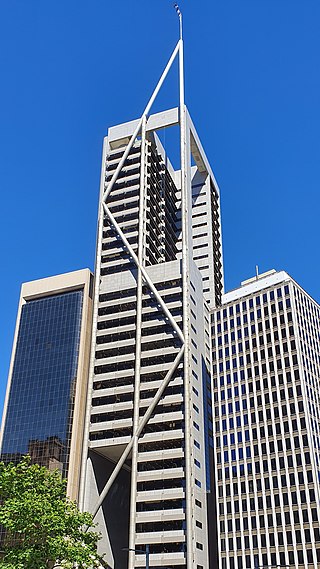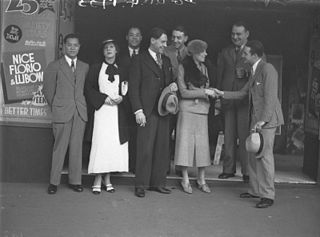
Darling Harbour is a harbour adjacent to the city centre of Sydney, New South Wales, Australia that is made up of a large recreational and pedestrian precinct that is situated on western outskirts of the Sydney central business district.

Harry Seidler was an Austrian-born Australian architect who is considered to be one of the leading exponents of Modernism's methodology in Australia and the first architect to fully express the principles of the Bauhaus in Australia.

Bondi Junction is an eastern suburb of Sydney, in the state of New South Wales, Australia. It is 6 kilometres east of the Sydney central business district and is part of the local government area of Waverley.

Sydney Tower, also known as Westfield Tower and formerly as Centrepoint Tower, is an observation and telecommunications tower that is the tallest structure in Sydney, New South Wales, Australia, as well as the second-tallest observation tower in the Southern Hemisphere. Sydney Tower has also previously been known as AMP Tower, and colloquially as Flower Tower, Glower Tower, and Big Poke.

25 Martin Place is a skyscraper in Sydney, Australia. Originally named the "MLC Centre" after MLC Limited, and still commonly referred to by that name, in 2021 the name was removed by its owner, Dexus, which now refers to the building simply by its street address of 25 Martin Place.

Killara is a suburb on the Upper North Shore of Sydney in the state of New South Wales, Australia. Killara is located 14 kilometres (8.7 mi) north-west of the Sydney central business district in the local government area of Ku-ring-gai Council. East Killara is a separate suburb and West Killara is a locality within Killara.

Martin Place is a pedestrian mall in the Sydney central business district, New South Wales, Australia. Martin Place has been described as the "civic heart" of Sydney. As home to the Reserve Bank of Australia, the Commonwealth Bank, Macquarie Bank, Westpac and other corporations, it is also a centre of business and finance. The Sydney GPO is also located on Martin Place.

MLC School is an independent Uniting Church single-sex early learning, primary, and secondary day school for girls, located in the inner western Sydney suburb of Burwood, New South Wales, Australia. The school enrols students from early learning, through kindergarten to year 12.

Capita Centre, is now known as 9 Castlereagh St Sydney, is a skyscraper in Sydney, Australia. Located at 9-11 Castlereagh Street, it is 183 metres (600 ft) tall from spire and 158 metres (518 ft) tall from roof. The building was designed by Harry Seidler & Associates in 1984 and completed in 1989. The building won Royal Australian Institute of Architects (NSW) merit award 1991.

Rowe Street is a narrow laneway in the central business district of Sydney in New South Wales, Australia. Originally, Rowe Street ran between Castlereagh Street and Pitt Street, parallel to Martin Place. However, it now runs east–west off Pitt Street. Rowe Street was named in honour of Thomas Rowe, a prominent architect in New South Wales.

Dame Doratea Alice Lucy Walkden Fitton, was an Australian pioneering theatre entrepreneur, actress of stage and film and theatrical director and producer who established with 19 other actors The Independent Theatre Ltd. in North Sydney, New South Wales in 1930, which operated for forty-seven years.

The Australia Hotel was a hotel on Castlereagh Street, Sydney in New South Wales, Australia. From its opening in 1891 until its closure on 30 June 1971 and subsequent demolition, the hotel was considered "the best-known hotel in Australia", "the premier hotel in Sydney" and described itself as "The Hotel of the Commonwealth". The hotel was situated in one of Sydney's important thoroughfares in the Sydney central business district.

MLC was an Australian business that provides investments, insurance and superannuation solutions to corporate, institutional, and retail customers. Due to divestments in the early 21st century, there are now two businesses, with no ownership links, that both use "MLC" in their branding:

Her Majesty's Theatre, Sydney, Australia, refers to three theatres of the same name none of which remain standing. They were located in central Sydney on either Pitt Street or Quay Street.

The New Tivoli Theatre, Sydney, previously known as the Adelphi Theatre and the Grand Opera House, was a theatre and music hall at 329, Castlereagh Street, Sydney, Australia, which was long at the heart of the Tivoli circuit.

The Garrick Theatre was a theatre and music hall at 79–83 Castlereagh Street in Sydney from 1890 to 1929. The theatre was renamed the Tivoli Theatre in 1893 and operated as a popular vaudeville venue. It was destroyed by fire in 1899 and rebuilt. The theatre closed in 1929.
Joseph Wyatt was a theatre owner and manager, in the early years of theatre in Sydney, Australia.
The Royal Lyceum was a small theatre in York Street, Sydney founded in 1854, which was redeveloped and renamed many times, finally as the Queen's Theatre, by which name it closed in 1882.

The Prince of Wales was a theatre in Castlereagh Street, Sydney, New South Wales. It was destroyed by fire and rebuilt twice; the second time as the Theatre Royal.
The National Amphitheatre was a boxing stadium and entertainment venue at 73–75 Castlereagh Street, Sydney, New South Wales. Rebuilt as a theatre for vaudeville productions by the Fuller brothers, it was refurbished and renamed several times.


















